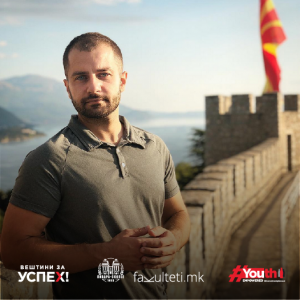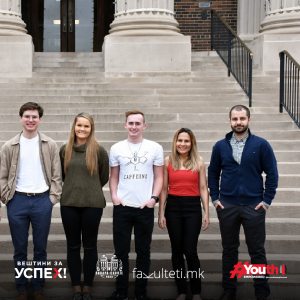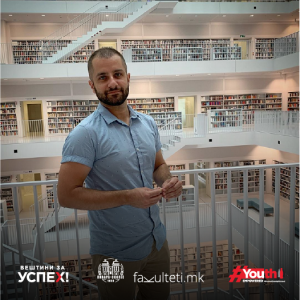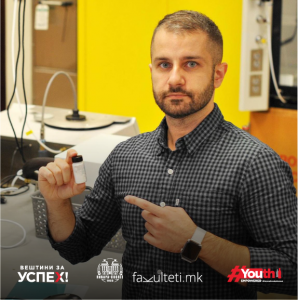“CLIMBING UP THE LADDER OF SUCCESS” WITH TOMCHE RUNCHEVSKI: TO ADVANCE, CHOOSE A TEAM AND A MENTOR WITH SUSTAINABLE TRACK RECORD IN PUBLISHING IN RENOWNED SCIENTIFIC JOURNALS
Their personal qualities have brought them a significant professional success. These are the stories of successful people published in the section “Climbing up the ladder of success”. Fakulteti.mk and Pivara Skopje Educational Center in the training “Skills to succeed” show you the way to stars.
From a student passionately interested in biology, to a cooperation with the U.S. National Aeronautics and Space Administration NASA, where he is to give a lecture very soon. As early as he can remember, science was to be his profession. Although he was born in Bitola, just because there is no maternity ward in Resen, he says that 100% Prespa blood runs in his veins. This is the story of Tomche Runchevski, PhD, an Assistant Professor at the South Methodist University (SMU) Dedman College of Humanities and Sciences in the USA, and a chair of department who runs a physical chemistry research group.
He grew up in Resen, where he finished his primary and secondary education. Biology was his first love, up until seventh grade, when he met chemistry.
– It was then I realized that one day I would be a chemist. In high school, I had a great chemistry teacher, Kate Nastevska, which has pushed me to decide and to focus on this area. Deep down, I have always known that science was going to be my profession – as I have always been genuinely interested in how the world works and why things are the way they are. I could never imagine myself doing a routine 9 to 5 job. And thirdly, since I was very young, I just couldn’t stay focused on one thing for too long, so I always needed something to constantly encourage me to move forward. Professional science is the single path that was sufficiently dynamic for me, one that gives you freedom, one that encourages critical thinking and finally, one that is never boring – says Runchevski.
Beginnings at the Chemistry Institute
Back when he was in high school, he realized that the most objective way of measuring quality in science is published scientific works.After he graduated in 2006, he faced the dilemma of where to continue his education.He remembers that when he was doing a personal research trying to find additional information, he learned that the Chemistry Institute at the Faculty of Natural Sciences and Mathematics in Skopje had published more articles than all other institutes combined.That was just enough to help him decide where to continue his formal education.In the second year of studies, he started working on a scientific project in the team of the professorPanche Naumov (at the time working in Osaka, Japan), and the professors Petre Makreski, Gligor Jovanovski and Gjorgji Petrushevski.
– Wonderful team!It was pretty clear at the time that choosing the Faculty of Natural Sciences and Mathematics was the right choice for me – stated Runchevski.
After graduating from the Faculty, he started his master’s studies in the field of minerals from Macedonia with the professors Makreski and Jovanovski.In the meantime, he spent six months on a student exchange program at the Leipzig University, Germany.
– I really enjoyed my experience in Leipzig, and so I decided to get my PhD degree in Germany.
I got my PhD degree from the Max Planck Institute – which proved to be another excellent decision. Max Planck is a top-class institute, with more than 30 Nobel Prizes laureates (as it happened, I actually worked on the same floor as one renowned Nobel Prize winner). The scientific programs offered at the Institute are of excellent quality and I have really learned a lot. I was very lucky to be working with the professor Robert Dinnebier, an excellent scholar in his field of work, and we have managed to achieve a lot together. I got my PhD degree in a record time of 3 years (the average in Germany is four years). I was proudly awarded the Otto Hahn Medal, traditionally awarded for achievements in society awarded on the level of the whole Germany, in all areas. From natural sciences to law – says Runchevski.
American science system offers independence
He decided to limit his focus on structural and physical chemistry, which borders physics.He was particularly interested in diffraction and spectroscopic methods of researching structure of materials.That is why he decided to pursue the postdoctoral studies at Berkeley University of California.
– At Berkeley, I had the chance to be working with a famous scientist, the professor Jeff Long, and we were focusing on porous materials.I stayed there for three years before getting an independent position.In the course of those three years, I managed to familiarize myself with the American system of science.And sincerely, I think that it is much better than the European.At least, for me.In America, scientists are given a complete independence, which is not the case in Europe.Unfortunately, academic positions in Europe are most often limited.For example, if you are a professor at the Catalysis Department – you have to focus solely on catalysis.But, on the other hand, in the US, you can work on any field, as long as you have the funds required.It does not necessary has to be chemistry!And this freedom is essential to me – explained Runchevski.
He is currently working at the South Methodist University (SMU) in Dalas, US, where he is the chair of a department and runs a research group working in the field of physical chemistry. The University was founded back in 1911 by the Methodist Church, but now operates as a secular university enjoying e complete independence. Since recently, the strategy of SMU is to become a leading global scientific center and is investing significantly in science and new departments. Runchevski says that although the SMU is still relatively not very well known internationally, it is one of the most expensive universities to enroll in the US, among the top 30 universities in terms of tuition, offering an incredibly wide array of resources.
– Due to the freedom offered by American universities, I decided to focus on two different topics: a fundamental and applicative one. The first one refers to the chemical composition of Titan’s surface, Saturn’s moon, which is precisely a fundamental combination of chemistry and physics. The other topic is the crystal engineering and discovering/designing new materials – explains Runchevski.
Tiran research
He has achieved a noticeable success on both fields. A year and a half ago, NASA has announced that the new mission called New Frontiers will be dedicated to Tiran, Saturn’s moon. In addition to the Earth, Titan is the only body in the Solar System that has dense atmosphere, rain, lakes and seas and it is believed that life is possible, or that life has existed in the past or will appear in the future. In 2026, NASA is planning to send the Dragonfly rover, which will spend around 3 months on Titan’s surface. Before even announcing the mission, Runchevski’s research team had started doing some experiments which will help lean more about how Titan really looks like up close. The main objective of the team is to learn more what the structure of Titan’s surface looks like.Runchevski explains that the conditions on Titan are very similar, but at the same time, very different from the ones on the Earth.The both bodies have dense atmospheres, predominantly composed of nitrogen; they both have clouds and rains.However, on Titan, liquid methane rains instead of rainwater, and it rains in the lakes and seas which are mainly made of ethane.Seas and lakes are located on the poles, and dust deserts composed of organic molecules stretch along the equator.This entire world lies on a giant surface of frozen water, and there are also indications that there are ice volcanoes.This entire world is frozen, at temperature of -180 degrees Celsius.
At the begging of this year, Runchevski and his team have published the scientific paper entitled “The Crystal Structure of Zineb, 75 Years Later”. The paper deals with the pesticide called zineb (also known as Dithane) which in the past 75 years has become one of the most widely used chemical in the world, and it has also been used in Macedonia. Runchevski’s team has solved the crystal structure of zineb – and they have managed to locate precisely the atoms in the space, which was not simple to do, as zineb crystallizes into powder.
– Solving the structure of such sample is extremely difficult and challenging – as put in simple terms, it required solving the structure of billions of crystals simultaneously! Zineb is one of such materials. Our laboratory is among the several ones working on solving this type of problems – said Runchevski.
New discovery
Although completely aware that what he is about may not sound just right, Runchevski says that every young scientist in Macedonia wishing to pursue a professional scientific career should inevitably come to terms with the fact that sooner or later, they would just have to be ready to leave the country.
– However, if they have no chance of leaving and have to stay and pursue their education in Macedonia, he would recommend them to choose a mentor or team that has good track record in publishing in renowned journals. There is no other option to fundamental science. Anything else is just a mere improvisation – says Runchevski categorically.
He says that he has still to reach the pinnacle of his professional career.He is proud of the fact he has turned to a completely new topic of research in his independent career, Titan’s chemistry, as in the most of the cases, young professors usually follow the same path in terms researching the same field as their mentors.
– It is challenging proving yourself in a completely new field of work, especially as a foreigner in the United States, as someone with European educational background. One month ago, I was invited to give a lecture at NASA, and we were also given funding from the Agency. For me, this is the most important acknowledgment of the quality of the scientific work done by my team at the SMU – says Runcjevski.
According to him, there are many teams researching chemistry and focusing particularly on materials, but only rarely are those materials actually used in everyday life.
– Another successful example coming from my team is the design of a new formula of creatine, the most common fitness supplement in the world. Currently, there are two creatine formulations available on the market and their turnover is half a billion US dollars annually, only in America! We have successfully formulated a third option. A month ago, we have filed a patent application and just a week later, we were approached by a private company interested in developing the patent. Currently, we are in the stage of negotiations for production and we hope that we will manage to launch our formulation as a new product on the market in 2021 or 2022. I believe that this is an excellent example of applicative chemistry – ends the conversation Runchevski.














